Introduction and Quick Summary
Are you looking for a quick yet satisfying meal? Look no further than this delicious Beef and Vegetable Stir-Fry with Soy Sauce. This dish is not only packed with flavor but also offers a vibrant mix of colorful vegetables that makes it visually appealing. Whether you’re cooking for yourself or hosting friends, this stir-fry is sure to impress. In just under 30 minutes, you can whip up a delightful dinner that brings together tender beef strips and crisp vegetables all enveloped in a savory soy sauce blend.
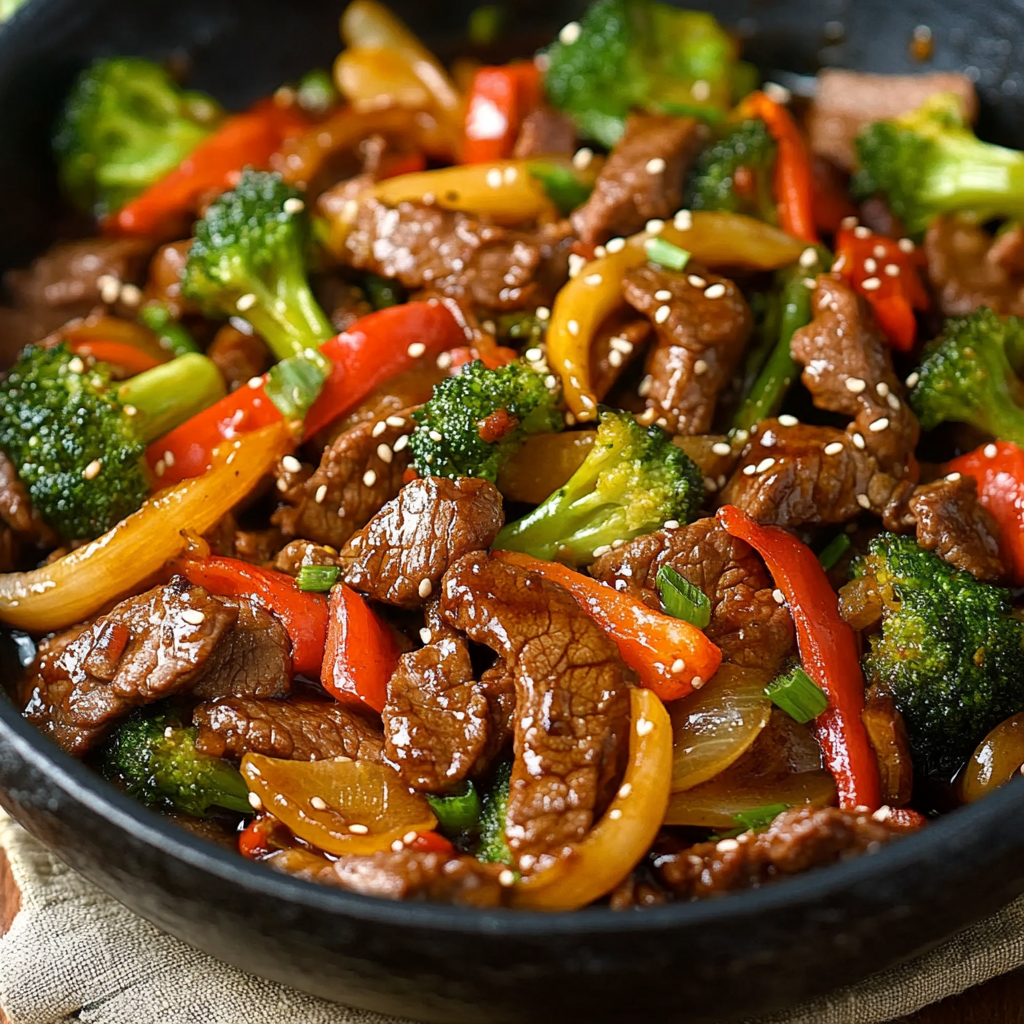
The beauty of this Beef and Vegetable Stir-Fry lies in its versatility. You can easily customize the vegetables based on what you have in your fridge or your personal preferences. Broccoli, bell peppers, carrots, and snap peas are excellent choices that complement the rich flavors of the beef. Not only is this dish quick to prepare, but it is also healthy, making it perfect for busy weeknights when you want something nutritious without sacrificing taste.
In this article, we will walk you through the main ingredients needed for this easy recipe as well as detailed preparation steps to ensure your stir-fry turns out perfectly every time. So grab your wok or skillet—it’s time to cook up some magic!
Main Ingredients
Fresh Beef
For our Beef and Vegetable Stir-Fry with Soy Sauce, you’ll need about one pound of fresh beef. Flank steak or sirloin works best due to their tenderness when cooked quickly over high heat. Slice the beef against the grain into thin strips about 1/4 inch thick. This method ensures that the meat remains tender after cooking. Marinating the beef briefly in soy sauce enhances its flavor while making it even more succulent.
Mixed Vegetables
Using a colorful array of mixed vegetables adds both nutrition and visual appeal to your stir-fry. You’ll require approximately three cups of chopped vegetables; great options include broccoli florets, bell peppers (red or yellow), sliced carrots, snow peas, and baby corn. Aim for a mix that offers crunchiness alongside sweetness to balance the robust flavor of the beef. Ensure all vegetables are cut into uniform sizes for even cooking.
Soy Sauce
Soy sauce is essential to our stir-fry’s distinctive flavor profile. Use 1/4 cup of low-sodium soy sauce to keep it from becoming too salty while still imparting that savory umami taste we love in Asian cuisine. If desired, you can substitute half of the soy sauce with oyster sauce for added depth.
Garlic and Ginger
To elevate the flavor further, use two cloves of minced garlic along with one teaspoon of freshly grated ginger root. These ingredients provide aromatic notes that complement both the beef and vegetables beautifully. They should be added early in the cooking process to release their natural oils and enhance the overall taste.
Cornstarch
A tablespoon of cornstarch is necessary for thickening our sauce slightly while giving it a glossy finish. Mix it with water before adding it during cooking; this ensures that it dissolves evenly without clumping.
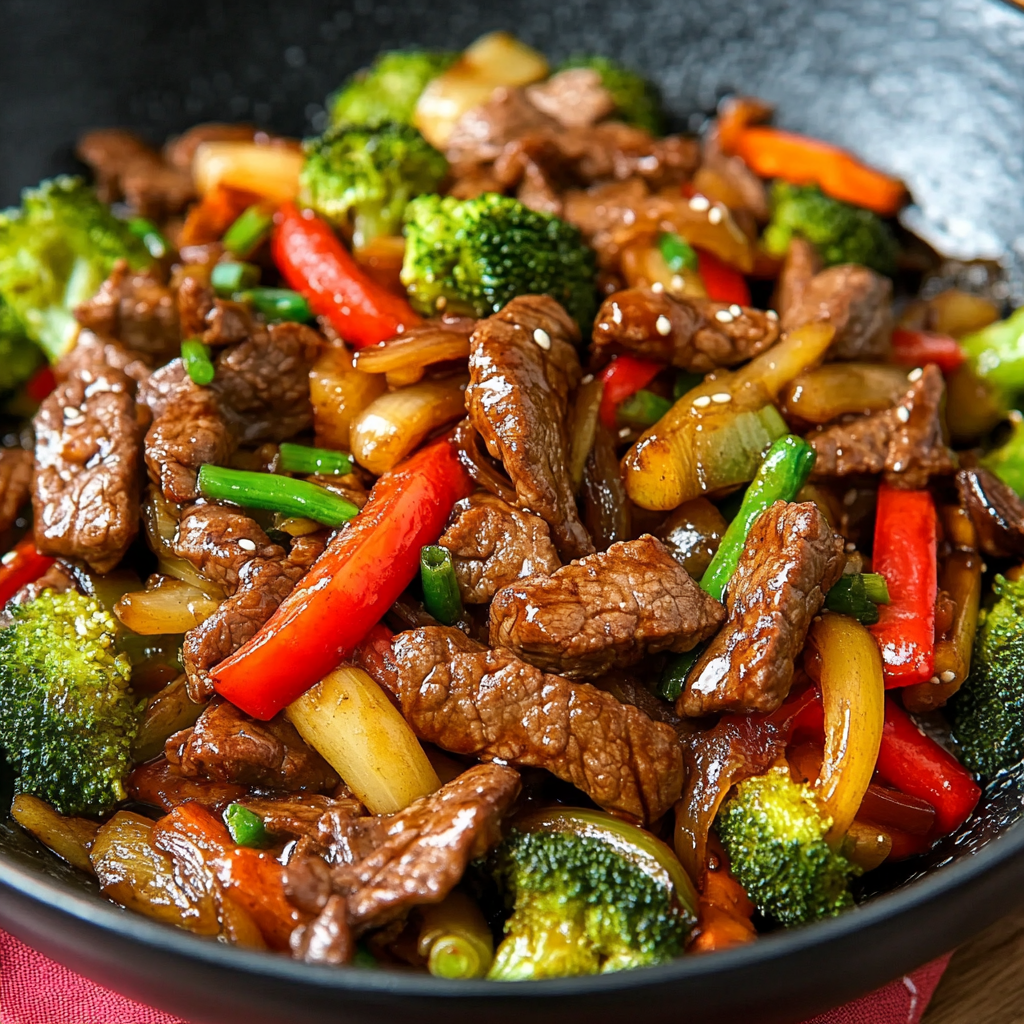
How to Prepare Beef and Vegetable Stir-Fry with Soy Sauce
Step 1: Prepare Your Ingredients
Start by gathering all your ingredients together on your kitchen counter. Wash all veggies thoroughly under running water; then chop them into bite-sized pieces as mentioned before—uniformity is key! Slice your beef against the grain into thin strips as well; this allows for easier chewing once cooked.
Once everything is prepped—set aside your chopped vegetables separately from your meat—and prepare your marinade by combining soy sauce, minced garlic, ginger root (freshly grated), and cornstarch mixed in water in a bowl large enough to hold the beef strips comfortably.
Step 2: Marinate the Beef
Place your sliced beef into the bowl containing your marinade mixture. Allow it to marinate for at least 15 minutes at room temperature—this step infuses flavor deeply into each piece while also tenderizing them further due to acidity from soy sauce! If you have more time available (up to an hour), feel free to refrigerate instead.
Step 3: Heat Your Wok or Skillet
Put a large wok or non-stick skillet over high heat until hot but not smoking—about two minutes should suffice if using an electric stove set on high settings! Add one tablespoon of vegetable oil once heated; swirl around evenly before adding marinated meat strips without overcrowding them.
Cook until browned on both sides—this usually takes around three minutes total depending on thickness—but avoid flipping too often! Instead let them sear properly first before stirring occasionally until fully cooked through (internal temperature should reach at least 145°F). Remove from pan onto plate once done!
Step 4: Stir-Fry Your Vegetables
Next up? Time for those vibrant veggies! Add another tablespoon of oil if necessary then toss in all prepared chopped veggies into hot pan where juices from previously cooked meat remain (flavors will marry beautifully!). Continue stirring vigorously over high flame until they turn bright yet tender-crisp—around four minutes total works well here!
While stirring continuously during this time frame helps prevent burning while ensuring even cooking throughout!
Step 5: Combine Everything Together
Once veggies reach desired tenderness level—as mentioned above—return previously cooked meat back into pan along with any leftover marinade mixture from earlier prep stage; combine thoroughly by folding everything together gently so all flavors meld nicely without breaking down ingredients too much!
Allow simmering briefly just long enough until warmed through (approximately one minute) before removing from heat source entirely!
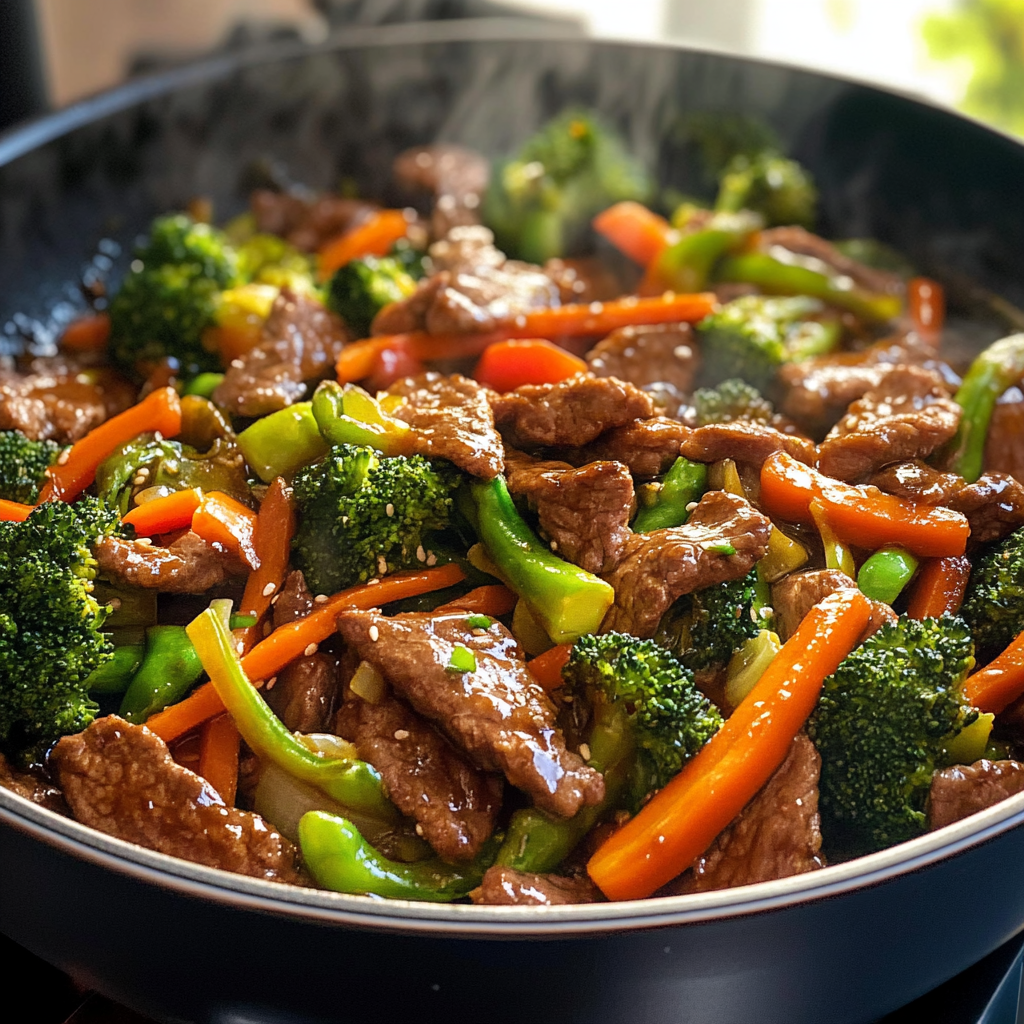
Serving and Storing Tips
Serving Suggestions
This Beef and Vegetable Stir-Fry pairs wonderfully over steamed rice or noodles depending on personal preference! For healthier options consider cauliflower rice instead—it’s low-carb while still providing texture similar enough not detracting away too much from original dish itself! Garnish generously using sesame seeds or sliced green onions right before serving enhances presentation significantly!
If you’re feeling adventurous add crushed red pepper flakes atop each plateful too—for those who enjoy extra spice kick! Remember serving portions typically yield four standard servings—so invite friends over next time!
Storing Leftovers
Should there be any leftovers after enjoying such delightful meal? Fear not! Allow remaining stir-fried goodness cool completely before transferring into airtight container; they can safely store inside refrigerator up-to three days maximum freshness maintained during duration within cool environment provided there isn’t any spoilage visible upon inspection later on!
For longer storage periods beyond three days freeze individual portions instead where they last around three months safely frozen without compromising quality much—but do remember thaw overnight prior reheating when ready consume again!
Reheat thoroughly either via microwave oven setting low power mode initially then increase gradually whilst checking every minute interval until reheated sufficiently throughout entirety—not forgetting potential need adding splash water help steam moistening back those ingredients which may dry out otherwise during cooling processes too!
Feel free now dive headfirst into creating unforgettable culinary experience today through homemade version beloved classic recipe everyone loves already—you won’t regret decision made here whatsoever!
Mistakes to avoid
When preparing Beef and Vegetable Stir-Fry with Soy Sauce, it’s essential to avoid common mistakes that can impact the flavor and texture of your dish. One significant mistake is not using the right cut of beef. Opt for tender cuts like sirloin or flank steak, which cook quickly and remain juicy. Avoid tougher cuts, as they require longer cooking times and can result in a chewy stir-fry.
Another mistake is overcrowding the pan. When you add too much beef and vegetables at once, it lowers the pan’s temperature, causing steaming instead of searing. This can lead to a soggy stir-fry rather than a crisp one. To prevent this, cook in batches if necessary.
Additionally, neglecting to prep your ingredients before cooking can lead to a rushed and unevenly cooked dish. Take the time to chop your vegetables uniformly and slice the beef thinly against the grain. This ensures quick cooking and enhances texture.
Using low-quality soy sauce can also negatively affect your Beef and Vegetable Stir-Fry with Soy Sauce. Always choose a good-quality soy sauce for deeper flavor; cheap varieties often contain additives that dilute taste.
Lastly, skipping the marination process for your beef is another mistake to avoid. A simple marinade with soy sauce, garlic, and ginger can significantly enhance the flavor profile of your stir-fry. Even 15-30 minutes of marination makes a noticeable difference in taste.
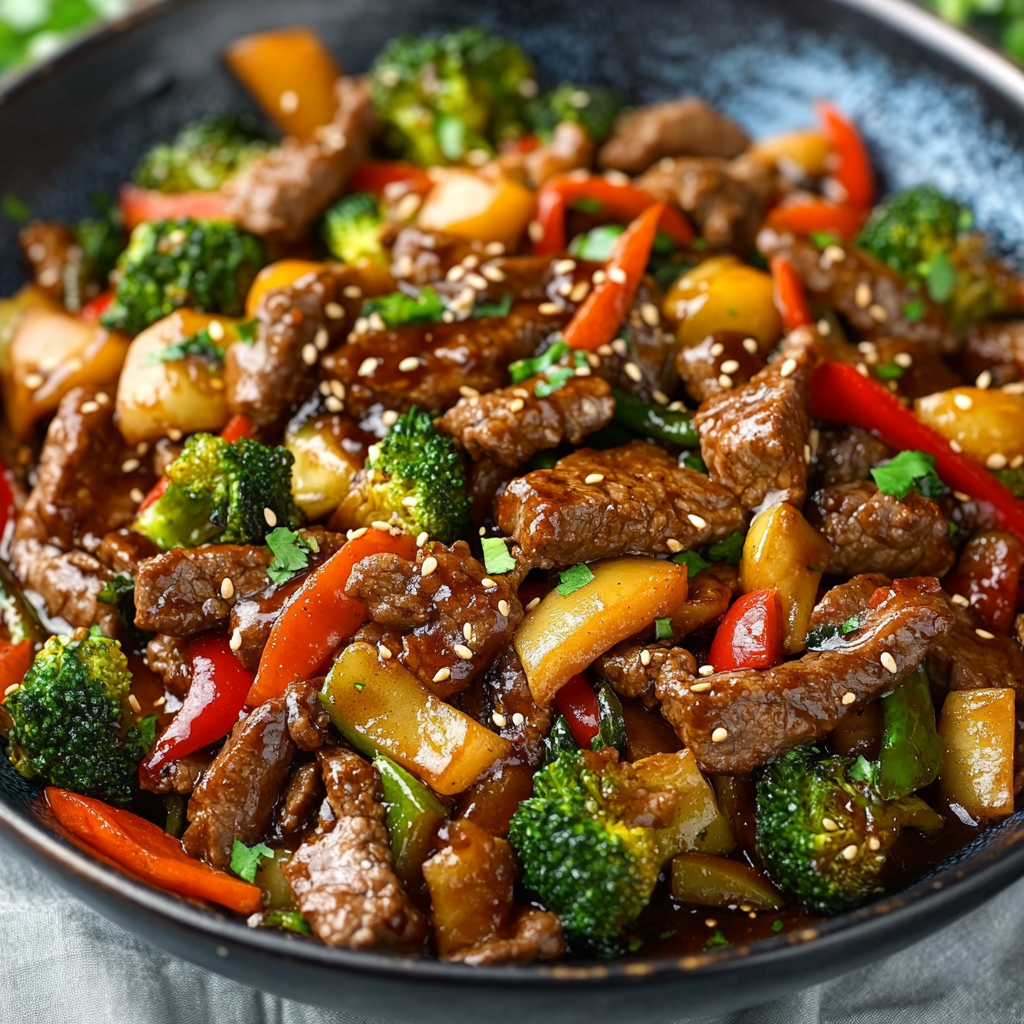
Tips and tricks
To elevate your Beef and Vegetable Stir-Fry with Soy Sauce, consider some helpful tips and tricks that ensure success every time you cook. Start by slicing your beef against the grain; this technique shortens muscle fibers, resulting in more tender bites. A sharp knife is crucial for making clean cuts.
Next, when selecting vegetables, aim for a variety of colors and textures. Bell peppers, broccoli, and snap peas not only enhance visual appeal but also provide distinct flavors that complement the beef beautifully. Always choose fresh vegetables for maximum crunchiness.
Timing is everything in stir-frying; have all ingredients prepped before you start cooking. Heat your wok or skillet until it’s very hot before adding oil—this prevents sticking and promotes even cooking.
Another useful tip is to use cornstarch as a thickening agent for your sauce. After marinating your beef, toss it lightly in cornstarch before cooking; this gives it a delightful crust while thickening the sauce during cooking.
Don’t forget about aromatics! Garlic and ginger should be added just before you incorporate liquids into the pan; this method releases their natural oils without burning them.
Lastly, finish off your dish with fresh herbs like cilantro or green onions for an added burst of flavor right before serving. These small touches make all the difference in creating an unforgettable Beef and Vegetable Stir-Fry with Soy Sauce.
Suggestions for Beef and Vegetable Stir-Fry with Soy Sauce
When preparing Beef and Vegetable Stir-Fry with Soy Sauce, there are several suggestions to enhance both flavor and presentation. First, consider incorporating different types of soy sauces for complexity; try mixing regular soy sauce with dark soy sauce for richness or adding a splash of oyster sauce for depth.
Utilizing seasonal vegetables can make your dish fresher and more vibrant. Varieties like asparagus in spring or bok choy in winter can elevate your stir-fry while reflecting seasonal produce availability.
For those looking to add some heat, consider including sliced chili peppers or a drizzle of sriracha in the final stages of cooking. This addition balances well with soy sauce’s umami flavors while offering an exciting kick.
Experimenting with alternative proteins such as chicken or tofu can provide new variations on this classic recipe while maintaining similar preparation methods. Adjusting ingredient ratios allows you to cater to dietary preferences without sacrificing taste.
If you’re preparing this dish for meal prep purposes, keep vegetables slightly undercooked so they retain crunch when reheated later on—this helps maintain texture over time.
Lastly, serve your stir-fry over steamed rice or noodles accompanied by sesame seeds or crushed peanuts as garnishes. Such toppings add both flair and crunch to your Beef and Vegetable Stir-Fry with Soy Sauce presentation.
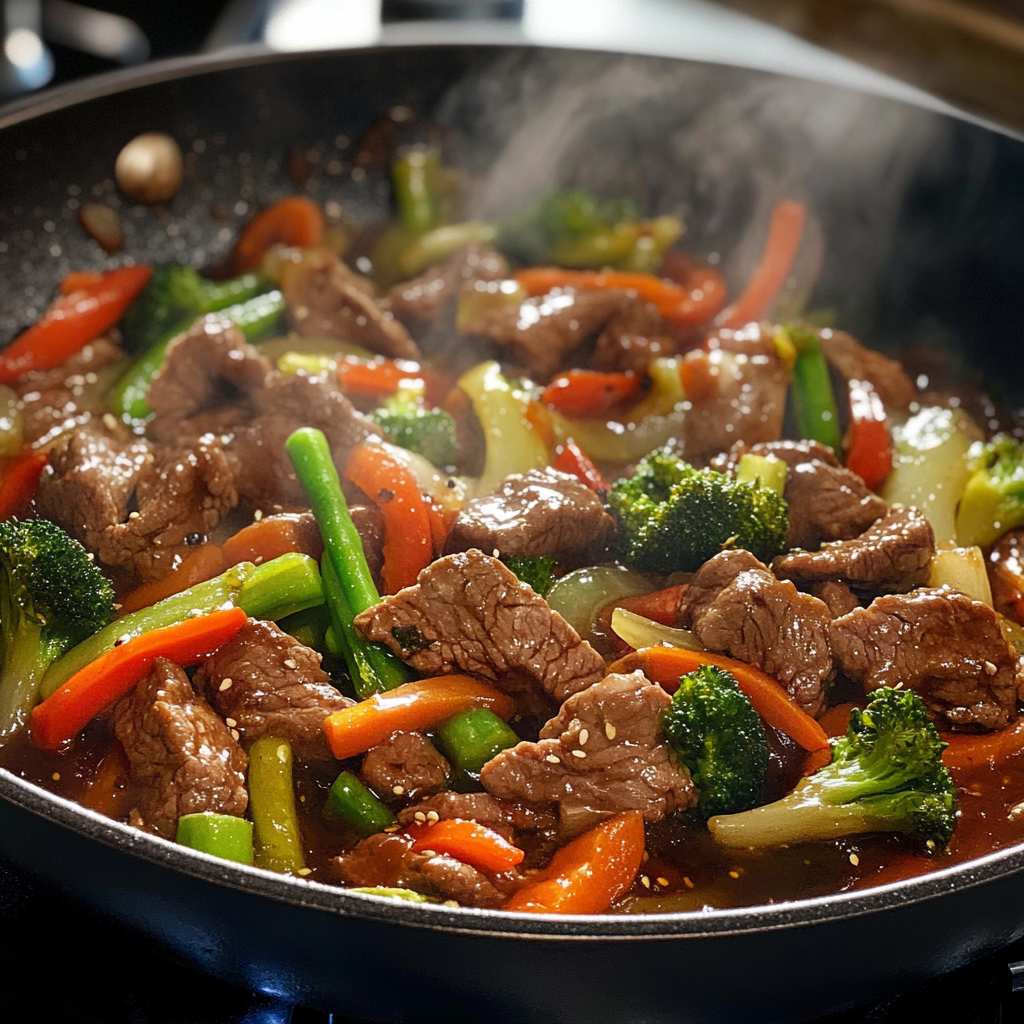
FAQs
What are some good vegetable options for Beef and Vegetable Stir-Fry with Soy Sauce?
When making Beef and Vegetable Stir-Fry with Soy Sauce, consider using bell peppers, broccoli florets, snap peas, carrots, or mushrooms as great vegetable options. These varieties provide color contrast along with unique textures that complement tender beef wonderfully.
How do I ensure my beef is tender in Beef and Vegetable Stir-Fry with Soy Sauce?
To ensure tenderness when preparing Beef and Vegetable Stir-Fry with Soy Sauce, slice against the grain using sharp knives for clean cuts that shorten muscle fibers effectively. Marinating briefly prior can also soften meat fibers while infusing flavor significantly.
Can I use frozen vegetables instead of fresh ones?
While fresh vegetables are preferred for their crispness when creating Beef and Vegetable Stir-Fry with Soy Sauce, frozen options can work if necessary due to convenience factors. However, be sure not to thaw them completely beforehand—cook directly from frozen instead!
How long should I marinate my beef?
For optimal results in enhancing flavors during preparation of Beef & Vegetable Stir-Fry With Soy Sauce: 15-30 minutes suffices! Longer periods might lead towards overly salty textures—balance is key!
What type of oil is best for stir-frying?
When making Beef & Vegetable Stir-Fry With Soy Sauce: neutral oils like vegetable oil or peanut oil perform best due their high smoke point! Avoid olive oil since its lower smoke point may result in undesirable burnt flavors during fast-paced cooking processes!
Can I make this dish gluten-free?
Yes! You can easily adapt Beef & Vegetable Stir-Fry With Soy Sauce into gluten-free versions by substituting traditional soy sauces (which contain wheat) utilizing tamari sauces specifically designed without gluten content!
Conclusion
In summary, making an exceptional Beef and Vegetable Stir-Fry with Soy Sauce involves avoiding common mistakes such as using tough cuts of meat or overcrowding the pan while prioritizing quality ingredients throughout preparation processes ensures richer flavors emerge seamlessly within each bite enjoyed together harmoniously! Implementing helpful tips like proper ingredient preparation techniques alongside thoughtful seasoning choices will enhance overall enjoyment further paving way towards culinary excellence achieved effortlessly every time served warm straight up onto dinner plates adorned beautifully across tables shared amongst loved ones gathered round enjoying delicious meals created lovingly from scratch together enhancing connections formed through food experiences shared!




